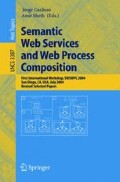Abstract
Business processes involve interactions among autonomous partners. We propose that these interactions be specified modularly as protocols. Protocols can be published, enabling implementors to independently develop components that respect published protocols and yet serve diverse interests. A variety of business protocols would be needed to capture subtle business needs. We propose that the same kinds of conceptual abstractions be developed for protocols as for information models. Specifically, we consider (1) refinement: a subprotocol may satisfy the requirements of a superprotocol, but support additional properties; and (2) aggregation: a protocol may combine existing protocols. In support of the above, this paper develops a semantics of protocols and an operational characterization of them. This supports judgments about the potential subclass-superclass relations between protocols, which are a result of protocol refinement. It also enables protocol aggregation by splicing a protocol into another protocol.
This research is supported by DARPA and by the National Science Foundation under grant DST-0139037.
Access this chapter
Tax calculation will be finalised at checkout
Purchases are for personal use only
Preview
Unable to display preview. Download preview PDF.
References
Huhns, M.N., Stephens, L.M., Ivezic, N.: Automating supply-chain management. In: Proceedings of the 1st International Joint Conference on Autonomous Agents and MultiAgent Systems (AAMAS), pp. 1017–1024. ACM Press, New York (2002)
(Rosettanet), http://www.rosettanet.org
Castelfranchi, C.: Commitments: From individual intentions to groups and organizations. In: Proceedings of the AAAI-1993 Workshop on AI and Theories of Groups and Organizations: Conceptual and Empirical Research (1993)
Singh, M.P.: Agent communication languages: Rethinking the principles. IEEE Computer 31, 40–47 (1998)
Singh, M.P.: An ontology for commitments in multiagent systems: Toward a unification of normative concepts. Artificial Intelligence and Law 7, 97–113 (1999)
Sirbu, M.A.: Credits and debits on the Internet. IEEE Spectrum 34, 23–29 (1997)
Mallya, A.U., Singh, M.P.: A semantic approach for designing commitment protocols. In: van Eijk, R., Huget, M.P., Dignum, F. (eds.) Proceedings of the AAMAS 2004 Workshop on Agent Communication (2004)
Yolum, P., Singh, M.P.: Flexible protocol specification and execution: Applying event calculus planning using commitments. In: Proceedings of the 1st International Joint Conference on Autonomous Agents and MultiAgent Systems (AAMAS), pp. 527–534. ACM Press, New York (2002)
Fornara, N., Colombetti, M.: Defining interaction protocols using a commitment-based agent communication language. In: Proceedings of the 2nd International Joint Conference on Autonomous Agents and Multiagent Systems (AAMAS), pp. 520–527. ACM Press, New York (2003)
Johnson, M.W., McBurney, P., Parsons, S.: When are two protocols the same? In: Huget, M.-P. (ed.) Communication in Multiagent Systems. LNCS, vol. 2650, pp. 253–268. Springer, Heidelberg (2003)
Malone, T.W., Crowston, K., Herman, G.A. (eds.): Organizing Business Knowledge: The MIT Process Handbook. MIT Press, Cambridge (2003)
Grosof, B.N., Poon, T.C.: SweetDeal: Representing agent contracts with exceptions using XML rules, ontologies, and process descriptions. In: Proceedings 12th International Conference on the World Wide Web (2003)
Fu, X., Bultan, T., Su, J.: Realizability of conversation protocols with message contents. In: Proceedings of the 2004 International Conference on Web Services, pp. 96–105. IEEE Computer Press, Los Alamitos (2004)
Peltz, C.: Web service orchestration and choreography. IEEE Computer 36, 46–52 (2003)
ebXML: Electronic business using extensible markup language (2002) Technical Specifications release, http://www.ebxml.org/specs/index.htm
Author information
Authors and Affiliations
Editor information
Editors and Affiliations
Rights and permissions
Copyright information
© 2005 Springer-Verlag Berlin Heidelberg
About this paper
Cite this paper
Mallya, A.U., Singh, M.P. (2005). A Semantic Approach for Designing E-Business Protocols. In: Cardoso, J., Sheth, A. (eds) Semantic Web Services and Web Process Composition. SWSWPC 2004. Lecture Notes in Computer Science, vol 3387. Springer, Berlin, Heidelberg. https://doi.org/10.1007/978-3-540-30581-1_10
Download citation
DOI: https://doi.org/10.1007/978-3-540-30581-1_10
Publisher Name: Springer, Berlin, Heidelberg
Print ISBN: 978-3-540-24328-1
Online ISBN: 978-3-540-30581-1
eBook Packages: Computer ScienceComputer Science (R0)

